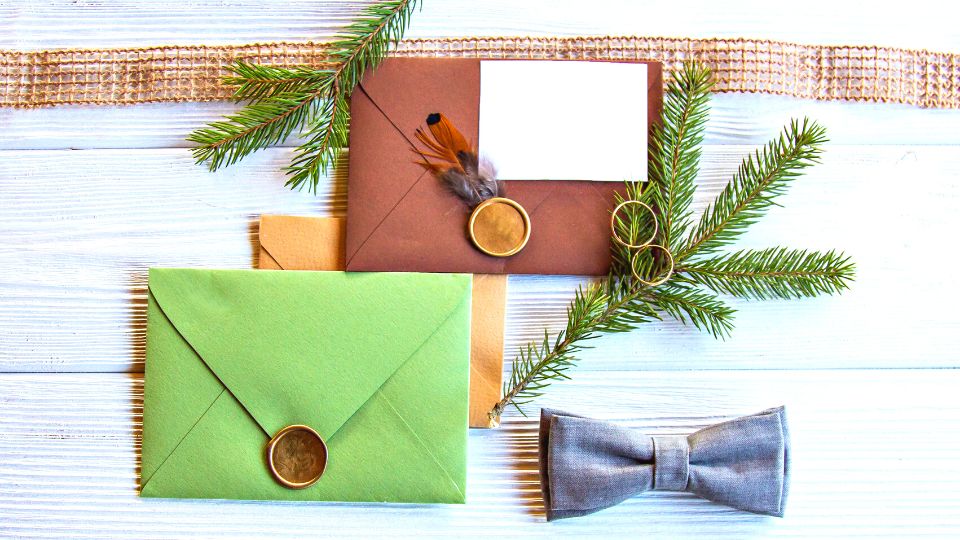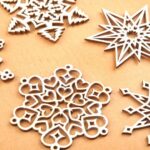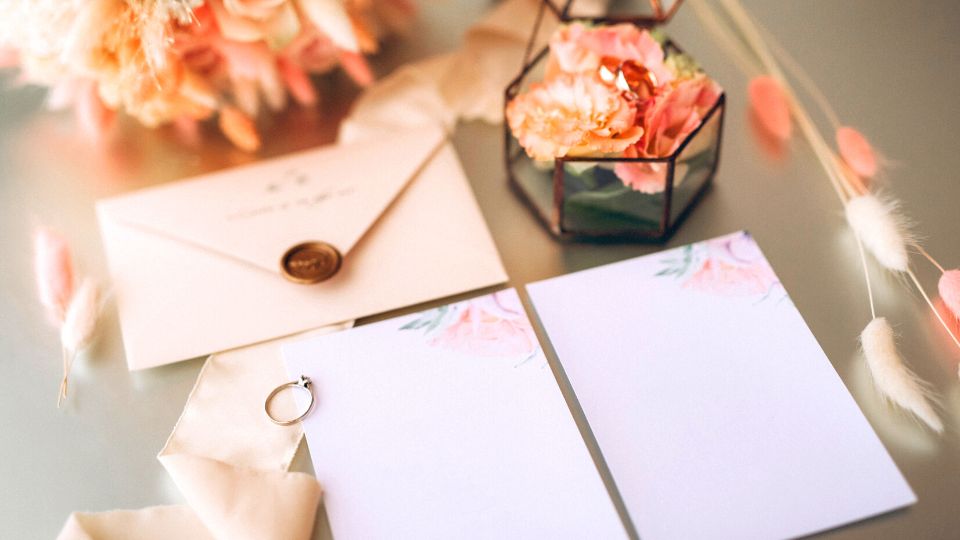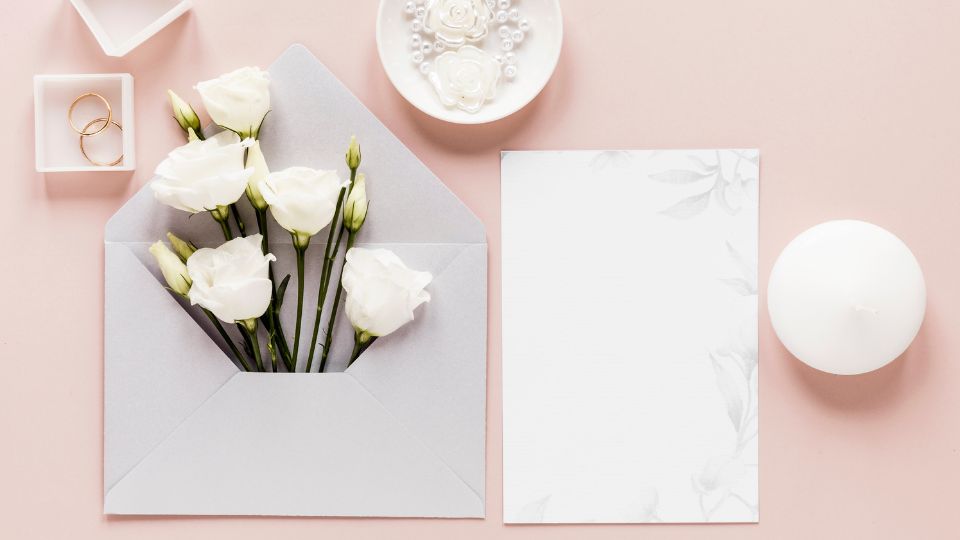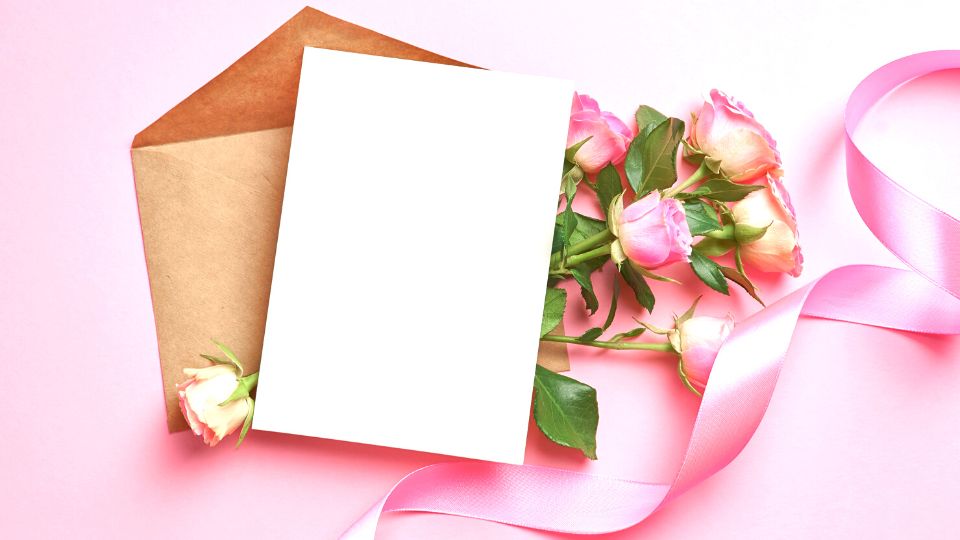Wedding invitations are more than just pieces of paper; they are the first glimpse of your special day that guests will receive.
Creating beautiful and memorable wedding invitations can set the tone for your entire wedding celebration. However, with so many options and styles to choose from, it can be overwhelming to navigate the world of wedding invitation design.
In this guide, we’ll explore the various aspects of wedding invitation design, from DIY options to custom designs, templates, trends, paper and printing options, typography and font selection, color choices, and assembling and mailing the invitations.
DIY Wedding Invitations
Wedding invitations are an important part of the wedding planning process, setting the tone and providing guests with the details of the big day. For some couples, the process of creating their own invitations is a fun and rewarding project that can save money and allow for a personal touch.
Here are some tips and tricks for crafting your own DIY wedding invitations.
Advantages of DIY wedding invitations
- Cost-effective: DIY invitations can save you money compared to buying pre-made invitations or hiring a designer.
- Personal touch: Crafting your own invitations allows for a unique, personal touch that reflects your style and personality.
- Creative freedom: DIY invitations give you creative control, allowing you to choose the colors, fonts, and designs that match your wedding theme.
Tips for crafting your own invitations
- Plan ahead: Give yourself plenty of time to plan and create your invitations. Consider the number of invitations you need to create, the design and materials, and the printing and assembly process.
- Choose your design: Select a design that matches your wedding theme and reflects your personal style. Consider using online templates or inspiration from social media or wedding blogs.
- Gather materials: Purchase all the necessary materials such as cardstock, envelopes, adhesives, and embellishments.
- Print and assemble: Use a high-quality printer to print your invitations, and assemble them carefully to ensure a professional finish.
Common mistakes to avoid when creating DIY invitations
- Poor quality printing: Ensure that your printer is set to the highest quality setting to avoid smudging or blurred text.
- Lack of attention to detail: Check your invitations carefully for spelling and grammar errors and ensure that all details are correct.
- Overcomplicating the design: Keep the design simple and elegant, avoiding too many colors, fonts, or embellishments that can make the invitation look cluttered.
- Failing to proofread: Ensure that you proofread the invitation multiple times to avoid any mistakes or typos.
Custom Wedding Invitations
Custom wedding invitations can add a personal touch and make a lasting impression on guests. Advantages of working with a designer include:
- Unique designs: A designer can create a one-of-a-kind invitation that reflects your personality and wedding style.
- Professional look: A designer can provide high-quality printing and paper options that may not be available with DIY or template options.
- Expertise: A designer can provide advice on wording, layout, and other design elements.
When selecting a designer, there are several factors that you should have in mind, such as:
- Budget: Custom invitations can be more expensive than other options, so it’s important to set a budget and find a designer who can work within it.
- Style: Look for a designer who specializes in the style you want for your invitations.
- Portfolio: Review the designer’s portfolio to ensure their style and previous work aligns with your vision.
- Availability: Be sure to select a designer who has availability to complete your project in a timely manner.
Tips for communicating your vision to the designer
- Provide inspiration: Share images and examples of designs you like to help the designer understand your vision.
- Be specific: Clearly communicate your wedding details, such as color scheme and wedding theme.
- Set expectations: Discuss timelines, revisions, and budget to ensure everyone is on the same page.
Pros and cons of custom invitation design:
Pros
- Unique and personalized designs
- High-quality printing and paper options
- Professional advice and expertise
Cons
- Higher cost than DIY or template options
- More time-consuming than other options
- Dependence on a designer’s availability and timeline.
Wedding Invitation Templates
Wedding invitation templates are a great option for couples who want to save time and money while still having beautiful and personalized invitations. These templates come in a wide variety of designs and styles, and can be customized to fit your wedding theme and colors.
Here are some things to consider when choosing and customizing wedding invitation templates:
- Variety of designs and styles: There are many websites and vendors that offer pre-made templates for wedding invitations. Browse through their collections to find a design that matches your wedding theme and style.
- Customization options: While templates come with pre-made designs, most of them also offer customization options. You can change the colors, fonts, wording, and even the layout to make it your own.
- Quality of printing: It is important to ensure that the printing quality of the template is high. Some templates may not print well, resulting in poor quality invitations. Always ask for a sample before placing a large order.
- Matching pieces: Many template designs come with matching pieces such as save the dates, RSVP cards, and thank you cards. If you want a coordinated look, this is a great option to consider.
- Cost: Using a pre-made template can be a cost-effective option for couples on a budget. However, be aware that some templates may have additional fees for customization or printing.
Once you have chosen your template, here are some tips for customizing it:
- Choose your colors: Select colors that match your wedding theme and colors. Many templates come with color options, but you can also customize them to your liking.
- Personalize the wording: Customize the wording to fit your personalities and wedding style. Consider adding a personal touch, such as a quote or poem.
- Add your own photos: If you have engagement photos or other pictures that you would like to include, look for a template that has photo options.
- Play with the fonts: Experiment with different font styles to create a unique and stylish invitation. Be sure to choose fonts that are easy to read.
Overall, wedding invitation templates offer a convenient and affordable option for creating beautiful and personalized invitations for your big day. With the right design and customization, you can create a unique and memorable invitation that reflects your personality and wedding style.
Paper and Printing
The paper and printing of your wedding invitations play a significant role in how your invitations look and feel. Here is an overview that covers everything you need to know about paper and printing for wedding invitations.
Overview of Different Types of Paper
There are many types of paper to choose from when it comes to wedding invitations. Some popular options include:
Cotton Paper
Cotton paper is made of 100% cotton fibers, which gives it a unique and luxurious feel. It has a high-quality and durable texture that works well for wedding invitations. Cotton paper is available in a variety of colors and finishes, including matte, textured, and shimmering.
Linen Paper
Linen paper has a similar texture to cotton paper, but it is made of wood pulp rather than cotton fibers. It has a subtle crosshatch pattern that gives it a distinct look and feel. Linen paper is available in various colors and finishes, including matte and glossy.
Parchment Paper
Parchment paper is a thin, translucent paper that is typically used for decorative purposes. It has a slightly rough texture and a vintage look that makes it ideal for rustic or vintage-themed weddings. Parchment paper is available in a variety of colors and finishes, including matte and glossy.
Vellum Paper
Vellum paper is a translucent paper that is often used as an overlay or to add a subtle, ethereal touch to wedding invitations. It has a smooth texture and is available in various colors and finishes, including matte and glossy. Vellum paper can be used on its own or layered with other paper types to create a unique and elegant look.
Overview of Printing Options
There are different printing options available for wedding invitations, including:
Digital Printing
Digital printing is a modern printing method that uses digital files to print designs onto paper. This printing technique is ideal for producing invitations with colorful designs or photographs. It is also cost-effective for printing small quantities of invitations.
Letterpress Printing
Letterpress printing is a traditional printing technique that uses a printing press to create a debossed impression onto paper. This printing method is known for producing elegant and classic invitations with a tactile finish. It is often used for formal and traditional wedding invitations.
Foil Stamping
Foil stamping is a printing method that uses heat and pressure to adhere a metallic foil onto paper. This printing technique adds a luxurious and shiny finish to invitations, and is often used for modern and contemporary designs. Foil stamping can be used to print text, designs, or borders in a range of metallic shades.
Thermography
Thermography is a printing technique that uses heat to create a raised, tactile effect on paper. It is similar to letterpress printing but more affordable. This technique is ideal for creating invitations with text or simple designs, and is often used for elegant and sophisticated invitations.
Wedding Invitation Trends
Wedding invitations set the tone for your big day and provide guests with a glimpse of what’s to come. From traditional and formal to modern and quirky, there are countless design options to choose from. Keeping up with the latest trends in wedding invitation design can help you create a beautiful and memorable invitation suite that reflects your personal style and wedding theme.
Here are some of the latest wedding invitation trends for 2023.
Bold Colors and Unique Color Combinations
2023 is all about bold and unexpected color choices. Couples are opting for unique color combinations that add a pop of personality to their invitations. Think jewel tones, metallics, and rich, saturated hues.
Floral and Botanical Designs
Floral and botanical designs are always in style for weddings, but in 2023, they are taking center stage. From delicate watercolor blooms to bold, graphic floral prints, there are endless ways to incorporate florals into your wedding invitations.
Minimalist and Modern Designs
Minimalist and modern designs are perfect for couples who want a clean and contemporary look for their wedding invitations. Think simple typography, clean lines, and plenty of white space.
Laser Cut Designs
Laser cut invitations have been growing in popularity in recent years, and they’re not going away any time soon. Laser cut designs offer intricate and detailed patterns that add a touch of elegance and sophistication to your invitations.
Eco-Friendly Materials
Couples are becoming more environmentally conscious, and this is reflected in their choice of wedding invitation materials. Recycled paper, seed paper, and other eco-friendly options are becoming increasingly popular for couples who want to minimize their impact on the environment.
Unique Printing Techniques
Digital printing is still the go-to choice for many couples, but in 2023, we’re seeing a rise in unique printing techniques like letterpress, foil stamping, and embossing. These techniques add texture and depth to your invitations and create a truly special and memorable piece.
Typography and Font Selection
The font you choose for your wedding invitation can convey a sense of formality, informality, elegance, or playfulness. It can also reflect the theme and style of your wedding, whether it’s a traditional black-tie affair or a whimsical outdoor celebration.
When selecting a font for your wedding invitation, consider the readability and legibility of the text. It is important to choose a font that is easy to read, especially for older guests who may have trouble with smaller text sizes or intricate script fonts.
Some popular font styles for wedding invitations include:
- Serif fonts: These fonts have small lines or flourishes at the end of each letter, giving them a classic and elegant feel. Examples of serif fonts include Times New Roman and Baskerville.
- Sans-serif fonts: These fonts do not have the small lines or flourishes and have a more modern and streamlined feel. Examples of sans-serif fonts include Helvetica and Arial.
- Script fonts: These fonts have a handwritten or calligraphic feel and are often used for formal or elegant weddings. Examples of script fonts include Edwardian Script and Zapfino.
Tips for using typography effectively in your design:
- Use a maximum of two fonts in your design to avoid overwhelming the reader.
- Make sure the font is large enough to read and does not blend into the background.
- Use bold or italics to emphasize certain text, such as the names of the couple or the date of the wedding.
- Consider using different font sizes and styles for different pieces of information, such as the main invitation versus the RSVP card.
Choosing Colors and Imagery
Colors can have a significant impact on our emotions and perceptions. In wedding invitation design, the colors you choose can help set the mood and tone for your wedding day.
For example, soft pastels may convey a romantic and delicate feeling, while bold and bright colors may evoke a more energetic and playful atmosphere. Consider the mood and tone you want to create for your wedding day when choosing your color scheme.
Choosing the right color scheme for your invitations
When selecting colors for your wedding invitations, it’s important to consider the overall theme and style of your wedding. If you have a specific wedding color palette in mind, incorporate those colors into your invitation design.
If you’re not sure where to start, consider choosing a neutral base color, such as white or ivory, and then adding pops of color through accent hues. You can also use color to highlight specific details on your invitation, such as your names or the date of your wedding.
Tips for incorporating imagery and motifs into your design
Imagery and motifs can add a personal and unique touch to your wedding invitations. If you have a specific theme or motif in mind, consider incorporating it into your design. For example, if you’re having a beach wedding, you could include seashells or starfish as a motif on your invitations.
You can also add imagery through custom illustrations, such as a drawing of your wedding venue or a map of the area. When incorporating imagery, it’s important to make sure it complements the overall design of your invitation and doesn’t overwhelm the text.
Assembling and Mailing Your Invitations
Assembling and mailing wedding invitations can be a daunting task for many couples, but with some preparation and organization, it can be a stress-free experience. Here are some tips for assembling and mailing your invitations:
Tips for Assembling Your Invitations
- Organize your materials: Lay out all your materials and ensure that you have everything you need, including invitations, envelopes, inserts, and any other additional items you plan to include.
- Prepare the invitations: Begin by folding the invitations and placing them in the envelope. If you have multiple inserts, place them in order of size, with the smallest on top.
- Seal the envelopes: Lick the adhesive on the envelope flap or use a damp sponge to moisten it. Press the flap down firmly to seal it.
Select the Right Envelope and Postage
- Choose the right envelope: Select an envelope that complements your invitation design and size. Consider using an inner envelope for a more formal touch, and an outer envelope for added protection.
- Weigh your invitations: Take your completed invitation to the post office to determine the correct postage. Ensure that you include the correct postage for the size, weight, and destination of your invitation.
- Add a return address: Always include a return address on the envelope in case any invitations are returned or undelivered.
Timing and Etiquette Considerations for Mailing Invitations
- Send invitations six to eight weeks before the wedding: This will give your guests ample time to RSVP and make travel arrangements.
- Consider sending save-the-dates: If you have out-of-town guests or are having a destination wedding, consider sending save-the-dates at least six months in advance.
- Include RSVP instructions: Make it clear how guests should RSVP, whether by email, phone, or mail. You may also want to include a deadline for RSVPs.
- Follow up with non-responders: After the RSVP deadline has passed, follow up with any guests who have not responded to ensure that you have an accurate headcount for your wedding.
Conclusion
In conclusion, designing the perfect wedding invitation is an exciting and creative process that requires careful attention to detail. Whether you choose to create your own DIY invitations, work with a custom designer, or use pre-made templates, there are many options available to help you achieve the desired look and feel for your invitations.
From typography and font selection to paper and printing techniques, there are many factors to consider when designing your invitations. Remember to have fun and let your creativity shine through, and your invitations are sure to be a beautiful and memorable reflection of your special day.
